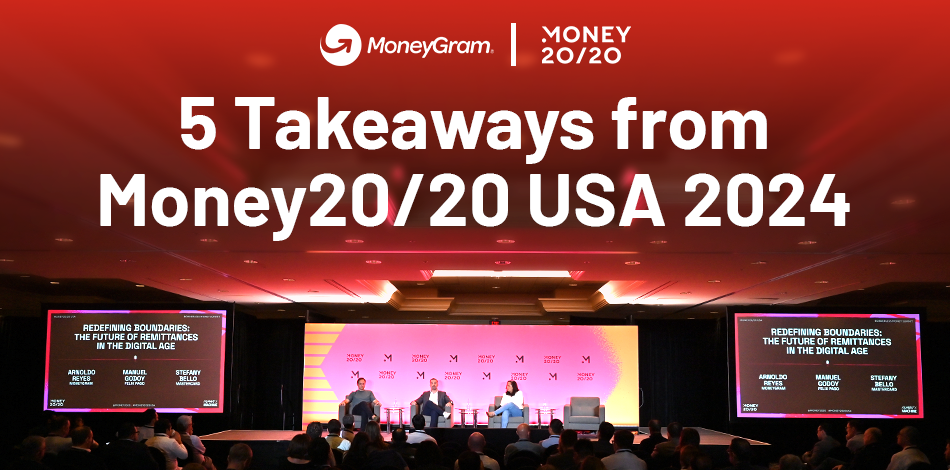
November 15, 2024 • News and Promotions~MoneyGram in the News

Money20/20 USA is the largest global fintech event. It brings the global money ecosystem together for four days in Las Vegas, Nevada, to discuss industry topics, form partnerships that bring value to consumers, and brainstorm on how to actualize the innovations we dream about.
I had the pleasure of speaking on the panel Redefining Boundaries: The Future of Remittances in the Digital Age with Mastercard’s Stefany Bello and Felix Pago’s Manuel Godoy. We dug into the digital advancements transforming traditional money transfer methods and the vast opportunities within Latin America for remittances. Later that evening, we co-hosted a ‘happy hour’ event with Mastercard to continue conversations with partners, analysts and other industry friends.

After averaging 11,000 steps a day across the event to speak with brilliant leaders from across the world, here are five key takeaways that my team and I are very excited about!

Financial inclusion has been a recurring topic over the last couple of decades across the financial services sector. Many governments, regulators and development organizations have placed financial inclusion at the top of their strategic priorities.
At Money20/20 USA, the topic made its debut with discussions around the importance of digital wallets in emerging economies such as Latin America, Southeast Asia and Africa. The biggest takeaway is that digital wallets (more so than neobanks) have and will continue to have a profound impact on financial inclusion rates.
In many ways, these wallets have become the operating systems for hundreds of millions of people. Most of these wallets provide access to a host of financial services, entertainment options and the purchasing of digital/physical goods – all within the same wallet app.
Digital wallets have become an effective tool in supporting inclusion efforts in three ways.
The most important message here was very clear. For large or small companies looking to access, service and scale their business in emerging economies, digital wallets become an absolute must. That is, in terms of how you can engage and deliver value through digital wallets and the massive user bases they hold.

The importance of partnerships as a strategic lever continues to be top of mind for incumbents and startups alike. Companies across all sectors of the payments industry are seeking novel ways to drive growth utilizing a wide array of partnership structures ranging from simple revenue share deals to corporate venture investments with preferential commercial rights.
Traditionally, we’ve seen large, publicly traded companies partner with private companies (i.e., startups) to reach specific customer segments, scale products and services across new channels, access unique expertise, etc.
The increase in private companies partnering with other private companies became more visible this year; for example, a payments startup partnering with a startup focused on onboarding and compliance. Many of these partnerships aim to reduce customer acquisition cost/increase lifetime value, improve NPS scores through better experiences, find product-market fit or trial concepts without requiring significant product and engineering investment.
Overall, the accepted belief is that this will fuel greater collaboration and growth of the sector while potentially leading to consolidation. There is usually no substitute for driving organic growth, but partnerships have undeniably become part of nearly all organization’s commercial arsenal.

We’ve sent tourists to space and decoded the human genome, yet sending cross-border payments continues to be a complex and inefficient process. Stablecoins could hold the promise of solving this at scale.
There was certainly a lot of talk around stablecoins at Money20/20 USA this year; the excitement was mostly driven by Stripe’s announcement to acquire Bridge (a stablecoin platform), the fast growth of PayPal’s PYUSD stablecoin, and a slew of payment companies that currently enable cross-border transfers on stablecoin infrastructure.
While there are a few structural elements that I believe need to fall in place to go full throttle with stablecoins (e.g., regulation), you can clearly see the signs and investments pouring into the space. More importantly, large payment players are rapidly embracing this technology as it potentially becomes the new operating platform for money movement.
While payments are the most talked about use case around stablecoins, numerous use cases were discussed; stablecoins can be leveraged as a hedging tool against market volatility or hyperinflation in emerging markets. The biggest takeaway here is that any company in the money movement space should understand, explore and engage with this technology as it promises to rewire the infrastructure of the financial services industry.

Payments is one of the most important and largest sub-sectors within the financial services industry; it touches just about everyone on Earth. While there has been noticeable innovation in consumer payments, business-business (B2B) payments have not materially changed over the last couple of decades. This is particularly true for cross-border B2B payments – a market that’s estimated to generate $250T in payment volume by 2027, according to Citi.
While B2B payments within itself is a large industry, there’s a surge in interest in servicing the cross-border payment needs of SMBs to middle-market specifically. We see this interest manifesting itself in many ways.
With increased global trade volumes, ‘borderless commerce’ and technology, there’s a growing need to better address this market. It’s also interesting how certain legacy payment companies are leveraging (or pivoting) their infrastructure to service the cross-border B2B segment. Why? Because some of these companies already have the network, the cross-border money movement ‘know-how’ and the recognizable brand. They understand the revenue opportunity of playing in the space in addition to the overall size of the market and its existing pain points.

You can’t go to a technology conference without hearing about the profound impacts of AI! Or at least, what it promises to do… This was no different at Money20/20 USA. Yet rather than talking broadly about AI, the most relevant takeaways were around the tactical applicability of this technology; what are some real examples of AI’s role in financial services today and into the future?
A few themes surfaced around the AI subject:
On the first point, the personalization topic goes back a few years – the notion that consumers want experiences that are maniacally tailored to their individual behaviors, interests and needs. In financial services, AI is ingesting and analyzing enormous data sets, creating something akin to knowledge graphs, and triggering highly personalized and curated experiences at scale. Rather than receiving generic ‘spend-and-get’ email offers from your credit card issuer, for example, you now get something so tailored to your needs that it’s almost certain you’ll jump on that call to action. And that just scratches the surface.
The second point is one of enormous importance given the hundreds of billions of dollars that consumers and companies lose to fraud. Lexis Nexis estimates that for every dollar lost to a fraudster, it costs financial institutions in North America $4.41. The positive implications of reducing fraud rates at scale in a dynamic and real-time way via AI is where a lot of talent and investment dollars are flocking to. AI will have decision-making capabilities that far outweigh those of today’s most innovative fraud management platforms. It’s just a matter of time before we see this become mainstream.
Finally, AI as a co-pilot to professionals in the industry is something that’s already being tested and implemented. Think of the financial advisor who spends hours analyzing the best asset allocation strategies for a client, or the time it takes a company’s treasurer to research which counterparty is providing the best FX rates, etc. All these use cases are perfect examples of where an ‘AI co-pilot’ can be deployed, allowing non-AI tasks to be optimized (e.g., relationship management efforts with clients, partners).
If these insights intrigue you, I encourage you to contact my team and learn how MoneyGram’s worldwide physical and digital network can open up new opportunities for your global business.
